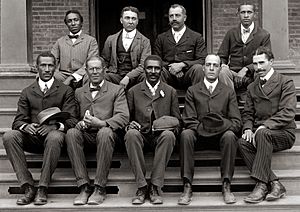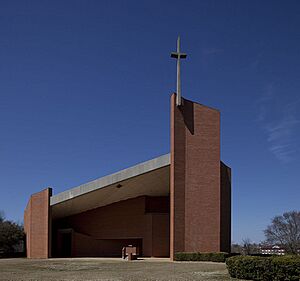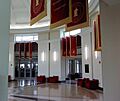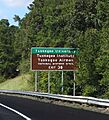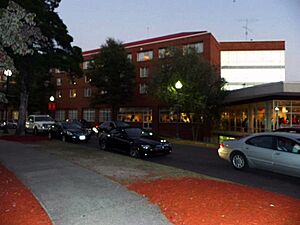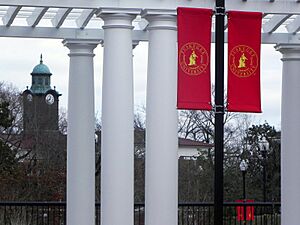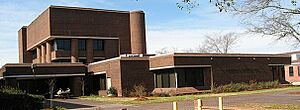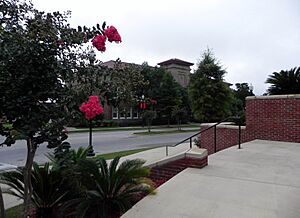Tuskegee University facts for kids
 |
|
|
Former names
|
Tuskegee Normal School for Colored Teachers (1881–1891) Tuskegee Normal and Industrial Institute (1891–1937) Tuskegee Institute (1937–1985) |
|---|---|
| Motto | Scientia Principatus Opera |
|
Motto in English
|
Knowledge, Leadership, Service |
| Type | Private historically black land-grant university |
| Established | July 4, 1881 |
| Accreditation | SACS |
|
Academic affiliations
|
|
| Endowment | $157 million (2021) |
| President | Mark Brown |
|
Academic staff
|
263 Full-time and 45 Part-time (Spring 2022) |
| Students | 2,570 (Fall 2022) |
| Undergraduates | 2,100 (Fall 2022) |
| Postgraduates | 215 (Fall 2022) |
| Location |
,
,
United States
32°25′48.76″N 85°42′27.81″W / 32.4302111°N 85.7077250°W |
| Campus | Rural, 5,200 acres (2,100 ha) |
| Newspaper | The TU Campus Digest |
| Colors | Crimson and old gold |
| Nickname | Golden Tigers |
|
Sporting affiliations
|
NCAA Division II – SIAC |
 |
|
Tuskegee University (also known as Tuskegee or TU) is a private university in Tuskegee, Alabama. It's a special kind of school called a historically black university. This means it was founded to provide higher education for African Americans. The school started on July 4th, 1881. The state of Alabama helped create it.
In 1974, the campus became a National Historic Site. This means it's a very important place in American history. Many famous African American people have been part of Tuskegee. These include its founder, Booker T. Washington, the amazing scientist George Washington Carver, and the brave World War II pilots known as the Tuskegee Airmen.
Tuskegee University offers many different study programs. You can earn a bachelor's degree in 43 subjects, like architecture. There are also 17 master's degree programs and five doctoral programs, including one for future vets (Doctor of Veterinary Medicine). Almost 3,000 students from the U.S. and over 30 countries study here.
The campus was designed by Robert Robinson Taylor, the first African American to graduate from the Massachusetts Institute of Technology. He worked with David Williston, the first professionally trained African American landscape architect.
Contents
History of Tuskegee University
How Tuskegee Started
Tuskegee University began on July 4, 1881. It was first called the Tuskegee Normal School for Colored Teachers. This school came about because of an agreement during the 1880 elections in Macon County, Alabama. A politician named W.F. Foster wanted to be re-elected. He made a deal with a local black leader, Lewis Adams. Foster promised to help create a school for black people if Adams could get black voters to support him. Most people in Macon County were black, so their votes were powerful. Adams succeeded, and Foster kept his promise.
The school was part of a bigger effort to create more colleges for black people in the Southern states after the American Civil War. Many of these schools were started by groups from the North. Lewis Adams, who used to be enslaved, dreamed of a school for teachers. He worked with George W. Campbell, a banker and former slaveholder, who also believed in education for black people. Adams was a skilled worker and a respected leader in his community.
Adams and Campbell got $2,000 from Alabama for teachers' salaries. But they had no money for land or buildings. They asked the Hampton Institute in Virginia to recommend a teacher. Samuel C. Armstrong, Hampton's principal, suggested 25-year-old Booker T. Washington. Washington was a former student and teacher at Hampton.
Booker T. Washington became the first principal. He started classes in an old church and a small shack. The next year, in 1882, he bought 100 acres of a former plantation. Students helped build the first campus buildings as part of their studies. By the early 1900s, Tuskegee Institute covered almost 2,300 acres.
Washington wanted to teach students practical skills, good morals, and religious values, along with regular school subjects. He encouraged his trained teachers to go back to rural areas. There, they would teach people new ways to farm and improve their lives. Washington's second wife, Olivia A. Davidson, was very important to Tuskegee's success. She helped raise money from people who wanted to support the school.
Over time, Tuskegee also started programs to help people in rural areas who couldn't come to campus. Tuskegee graduates went on to start other schools and colleges across the South. They continued to focus on training teachers.
Booker T. Washington's Leadership

| Booker T. Washington | 1881–1915 |
| Robert Russa Moton | 1915–1935 |
| Frederick Douglass Patterson | 1935–1953 |
| Luther H. Foster Jr. | 1953–1981 |
| Benjamin F. Payton | 1981–2010 |
| Gilbert L. Rochon | 2010–2013 |
| Brian L. Johnson | 2014–2017 |
| Lily McNair | 2018–2021 |
| Charlotte P. Morris | 2021 (effective August 1) |
After the Civil War, Booker T. Washington, who was born enslaved, worked hard to get an education. He attended Hampton Normal and Agricultural Institute and Wayland Seminary. He then returned to Hampton as a teacher.
As the new principal in Tuskegee, Washington opened his school on July 4, 1881. He started in a church building. The next year, he bought land from a former plantation and expanded the school over many years.
Washington believed in self-reliance. He trained teachers and also taught practical skills. These skills helped students succeed in farming or other jobs common in the rural South. He wanted his students to see hard work as valuable and honorable. Students built most of the new campus buildings themselves. Many students paid for their education by working on campus farms or in other jobs.
During this time, black people in the South faced increasing unfairness. After the Democrats took back power in state governments, they created laws that separated people by race (racial segregation) and limited black people's rights. Washington's ideas about education became a topic of debate. Some leaders, like W.E.B. Du Bois, believed black people should also have opportunities for traditional academic studies, not just job training.
Washington brought important scholars to Tuskegee, including the famous botanist George Washington Carver.
Early Years (1881–1900)
Washington became a well-known speaker for "industrial" education for black people. He connected with many wealthy American people who donated money to the school. These included Andrew Carnegie (who funded a library), Collis P. Huntington, John D. Rockefeller, and George Eastman. Henry H. Rogers was a major secret donor to Tuskegee and other black schools for over 15 years.
Tuskegee also had many students from Cuba during these years. After some early efforts to recruit students from the island, the university became very popular among ambitious Afro-Cubans. For the first 30 years, dozens of Afro-Cubans enrolled each year, making them the largest group of international students.
Growth and Change (1900–1915)
Washington formed a strong relationship with Julius Rosenwald, who was the head of Sears, Roebuck and Company. Rosenwald cared deeply about the lack of education for black people in the South. He joined Tuskegee's board of directors and worked with Washington to get funding for teacher training schools like Tuskegee.
Washington worked tirelessly to raise money for Tuskegee. In 1905, he started a campaign to build up the school's funds. He gave a famous speech at Carnegie Hall in New York in 1906, celebrating the school's 25th anniversary.
Starting in 1912, Rosenwald helped create model rural schools. Tuskegee architects designed the plans, and some students helped build these schools. Rosenwald set up a fund, but he required communities to raise their own money too. This encouraged black and white people in local areas to work together. Rosenwald and Washington helped build and run over 5,000 small community schools for black children across the rural South until the 1930s.
Washington remained the principal of Tuskegee despite his many travels. He died in 1915 at age 59 from high blood pressure. At the time of his death, Tuskegee had over $1.5 million in its funds. He was buried on campus near the chapel.
Tuskegee also worked with church groups to set up job training programs in Africa.
Later Years (1915–1940)
After Washington passed away, Robert Russa Moton became the principal for the next 20 years.
The years after World War I brought new challenges for Tuskegee. Teaching was still important, but Southern society was changing fast. Many black people moved from the South to Northern and Midwestern cities. They were looking for factory jobs and escaping unfair treatment and violence. This movement was called the Great Migration. Tuskegee's programs, which focused on farming, had to adapt to these changes.
World War II and Beyond
In 1941, the U.S. Army Air Corps started a program at Tuskegee Institute to train black aviators (pilots). They used Moton Field, which was about 4 miles from campus. The pilots who graduated from this program became famous as the Tuskegee Airmen. Today, the Tuskegee Airmen National Historic Site is at Moton Field. The U.S. Army, Air Force, and Navy still have R.O.T.C. programs at Tuskegee today.
Many presidents have visited Tuskegee, including Franklin D. Roosevelt. His wife, Eleanor Roosevelt, was also very interested in the school and its flight program. In 1941, she visited Moton Field. She worked to make sure African Americans had the chance to become military pilots. She often supported Tuskegee's programs.
After the war, Tuskegee continued to grow. It added new programs and departments, including graduate studies. For example, its School of Veterinary Medicine started in 1944. Mechanical Engineering was added in 1953, and a four-year Architecture program in 1957.
In 1985, Tuskegee Institute officially became Tuskegee University.
In 2020, a generous person named MacKenzie Scott donated $20 million to Tuskegee. This was the largest single gift from a known donor in the university's history. In 2024, another anonymous donor gave $20 million to support STEM programs and campus improvements.
In May 2024, Mark Brown became the first Tuskegee graduate (Class of 1986) to be appointed president of the university.
Tuskegee Institute National Historic Site
|
Tuskegee Institute National Historic Site
|
|
| Nearest city | Tuskegee, Alabama |
|---|---|
| Built | 1882 |
| Architect | Robert Robinson Taylor |
| Architectural style | Greek Revival, Queen Anne |
| Website | Tuskegee Institute National Historic Site |
| NRHP reference No. | 66000151 |
| Significant dates | |
| Added to NRHP | October 15, 1966 |
| Designated NHL | June 23, 1965 |
In 1965, Tuskegee University was named a National Historic Landmark. This was because of its important academic programs, its role in educating African Americans, and its place in U.S. history. In 1974, Congress created the Tuskegee Institute National Historic Site.
This historic site includes Booker T. Washington's home, The Oaks, and the George Washington Carver Museum. The entire Tuskegee University campus at that time is part of the historic district. Important places within the site include:
- The Oaks (Booker T. Washington's home)
- The Booker T. Washington monument, called Lifting the Veil of Ignorance
- The graves of Booker T. Washington and George Washington Carver
- The George Washington Carver Museum
The Tuskegee Airmen National Historic Site is also nearby, at Moton Field.
Campus Life at Tuskegee
Tuskegee University has its own Campus Police. They keep students and staff safe 24 hours a day, both on and off campus. All officers are certified by the state.
Kellogg Hotel & Conference Center
The Kellogg Hotel & Conference Center is located on campus in the renovated Dorothy Hall (built in 1901). It opened in 1994 with help from the W.K. Kellogg Foundation. The center has meeting rooms with multimedia tools, a 300-seat auditorium, and a ballroom for up to 350 guests. Students studying Hospitality Management and Dietetics get hands-on experience working here. This is the only Kellogg Conference Center at a historically black university. There are only 11 such centers worldwide.
Academics and Programs
Tuskegee University has five colleges and two schools. These include:
- The College of Agriculture, Environment and Nutrition Sciences
- The College of Arts and Sciences
- The Brimmer College of Business and Information Science
- The College of Engineering
- The College of Veterinary Medicine, Nursing and Allied Health
- The Taylor School of Architecture and Construction Science
- The School of Education
Tuskegee also has an honors program for students with excellent grades.
Tuskegee University is officially approved by the Southern Association of Colleges and Schools Commission on Colleges. This allows them to give out bachelor's, master's, doctorate, and professional degrees. Many of its programs are also approved by national groups, such as Architecture, Business, Education, Engineering, Nursing, and Veterinary Medicine.
Tuskegee University is the only Historically Black University to offer a Doctor of Veterinary Medicine (D.V.M.) degree. Its School of Veterinary Medicine started in 1944. About 75% of all African American veterinarians in the U.S. graduated from Tuskegee's program.
Tuskegee University offers several Engineering degrees, all approved by ABET (a group that checks engineering programs).
The Aerospace Science Engineering department started in 1983. Tuskegee University is the first and only Historically Black University to offer an approved bachelor's degree in Aerospace Engineering. The Mechanical Engineering Department began in 1954, and Chemical Engineering in 1977. The Electrical Engineering Department is the largest in the College of Engineering.
The Tuskegee University Andrew F. Brimmer College of Business and Information Science is fully approved by the Association to Advance Collegiate Schools of Business (AACSB-International).
The School of Nursing started in 1892. In 1948, the university began offering a bachelor's degree in Nursing. This was the first bachelor's nursing program in Alabama. The Nursing department is fully approved by the National League for Nursing Accrediting Commission.
The Occupational Therapy program is approved by the Accreditation Council for Occupational Therapy Education (ACOTE). The Clinical Laboratory Science Program is approved by the National Accrediting Agency for Clinical Laboratory Sciences (NAACLS).
Tuskegee University first offered certificates in Architecture in 1893. The 4-year bachelor's degree in architecture began in 1957. The Robert R. Taylor School of Architecture offers two professional programs: Architecture and Construction Science and Management. The 5-year Bachelor of Architecture program is fully approved by the National Architectural Accrediting Board (NAAB). Graduates can become licensed architects.
In 2019, Tuskegee partnered with the Ross University School of Medicine. This helps more Tuskegee students get into medical school. Qualified students can get automatic admission and a free first semester.
In 2020, Tuskegee also partnered with the Cumberland School of Law. This allows Tuskegee students to earn both a bachelor's degree and a law degree in six years, instead of the usual seven.
University Rankings
- U.S. News & World Report ranked Tuskegee 3rd out of 79 Historically Black Colleges and Universities in 2022.
- U.S. News & World Report also rated Tuskegee 20th among "Best Regional Colleges in the South" in 2021.
- Washington Monthly ranked Tuskegee 109th among 614 master's universities in the U.S. in 2020. This ranking looks at how much schools help society through social mobility, research, and public service.
National Center for Bioethics
The National Center for Bioethics in Research and Health Care is the first center of its kind in the U.S. It focuses on important moral questions in medical research and treatment for African Americans and other groups who have not been treated fairly. The center opened two years after President Bill Clinton apologized for a past U.S. Public Health Service study (1932–1972). In that study, 399 poor African American men were part of a study where their disease was not treated. The center also has a Bioethics Honors Program for college students.
Tuskegee Athletics
Tuskegee is part of the National Collegiate Athletic Association (NCAA) Division II. They compete in the Southern Intercollegiate Athletic Conference (SIAC). The university has 10 sports teams. The men's teams are called the "Golden Tigers," and the women's teams are called the "Tigerettes."
The Men's Basketball team won the 2014 SIAC Championship and the 2014 NCAA Division South Region Championship. They also made it to the Elite Eight in the 2014 NCAA Men's Division II basketball tournament. The Women's Softball team won the 2014 SIAC Championship.
Tuskegee offers the following sports:
|
Men's Teams |
Women's Teams |
Football
The Tuskegee University football team has won 29 SIAC championships, which is the most in SIAC history. As of 2013, the Golden Tigers are the most successful Historically Black College and University (HBCU) team with 652 wins.
In 2013, Tuskegee decided not to play their rival Alabama State University in the Turkey Day Classic anymore. Instead, after a great 10–2 season, the Golden Tigers made their first playoff appearance in school history for the 2013 NCAA Division II Football Championship. They played against the University of North Alabama but lost 30–27. Tuskegee won the 2014 SIAC Football Championship. They advanced to the first round of the NCAA Division II football playoffs but lost 20–17 to the University of West Georgia.
Baseball
The baseball team has won thirteen SIAC championships. Several players from Tuskegee have gone on to play professionally, including big-leaguers like Leon Wagner and Ken Howell.
Basketball
Tuskegee won the 2013–14 SIAC Championship. They then advanced to the 2014 NCAA Division II men's basketball tournament. Tuskegee won the NCAA Division II South Regional Championship by beating Delta State University 80–59. The Golden Tigers lost to the No. 1-ranked Metro State team, 106–87, in the Elite Eight of the NCAA Division II tournament.
Track and Field
Track and field began at Tuskegee for both men and women in 1916. The first Tuskegee Relays and Meet was held on May 7, 1927. It was the oldest African American relay meet.
The Tuskegee women's team won the Amateur Athletic Union national outdoor championship 14 times between 1937 and 1951. They also won the AAU national indoor championship four times.
Tuskegee's own Alice Coachman was the first African American woman to win an Olympic gold medal in any sport. She won it at the 1948 Olympic Games in London. Iram Lewis, a Tuskegee architecture graduate, is an Olympian relay runner who competed for the Bahamas.
The Marching Crimson Piper Band
The Marching Crimson Piper Band (MCP) is one of the oldest HBCU marching bands in the country, started in 1883. The band performs at TU sports events, on TV shows, at NFL games, the Honda Battle of the Bands, and Mardi Gras parades. The MCP is joined by the Crimson Piperettes (danceline) and Twirling Divas.
Notable Faculty and Staff
| Name | Department | Notability | Reference |
|---|---|---|---|
| J. Pius Barbour | Theology (1919–1921) |
Leader of the National Baptist Association and a mentor to Martin Luther King Jr. | |
| C. M. Battey | Photography (1916–1927) |
A photographer who took pictures of many black leaders and created covers for The Crisis magazine. | |
| George Ruffin Bridgeforth | Agriculture (1902–1918) |
Director of farming operations and teaching at Tuskegee. He was the first Black graduate from the University of Massachusetts Amherst (1901). | |
| James Nathan Calloway | Agriculture | Helped set up the Institute's Tuskegee-Togo Cotton Scheme. | |
| Nathaniel Oglesby Calloway | Chemistry | The first African-American to receive a PhD from Iowa State University (1930). | |
| George Washington Carver | A famous African American scientist, botanist, educator, and inventor. His work changed farming in the Southern United States. | ||
| Louis Edwin Fry Sr. | Architecture (1935–1940) |
An architect and professor. He was the first head of the new architecture department at Tuskegee Institute. | |
| P. H. Polk | Photography (1933–1938) |
A photographer who captured images of working-class African Americans, former slaves, and black leaders. He was also the official photographer for the institute for 40 years. | |
| William Augustus Hazel | Architecture | An architect, stained glass artist, educator, and civil rights activist. | |
| G. David Houston | A Professor of English at Howard University. | ||
| General Daniel "Chappie" James | A fighter pilot in the U.S. Air Force. In 1975, he became the first African American to reach the rank of four-star General. | ||
| Ruth Logan Roberts | Physical education | An activist for women's rights and health issues, and a leader in the YWCA. | |
| Lamina Sankoh | An early politician from Sierra Leone who taught at Tuskegee in the late 1920s. | ||
| Robert Robinson Taylor | Trades Department | The first African American graduate of MIT. He designed most of the Tuskegee campus buildings and started trade programs. He was second in command to Booker T. Washington. | |
| Andrew P. Torrence | President of Tennessee State University (1968-1974) and executive vice president at Tuskegee University (1974-1980). | ||
| Booker T. Washington | Appointed President (1881–1915) |
The first principal of the university. | |
| Josephine Turpin Washington | Mathematics | A 1886 Howard University alumni and early writer on civil rights. | |
| Deborah Wolfe | Education | An esteemed educator and minister, and Education Chief for a U.S. House of Representatives committee. | |
| Donald F. White | Architecture (1934–1938) |
A Canadian-born American architect and engineer. He was the first Black architect registered in Alabama (1935) and Michigan (1939). |
Notable Alumni
| Name | Class year | Notability | |
|---|---|---|---|
| Chalmers Archer | 1972 | Author of "Growing Up Black in Mississippi." | |
| Claude Albert Barnett | 1906 | Founder of the Associated Negro Press. | |
| Chokwe Antar Lumumba | 2005 | The 53rd mayor of Jackson, Mississippi. | |
| Robert Beck | A writer from the 1970s known as Iceberg Slim. | ||
| Bradford Bennett | A Negro League baseball player. | ||
| Charles Sumner Bowman | 1898 | An architect, educator, and director at Western University. | |
| Amelia Boynton Robinson | 1927 | An international civil and human rights activist. She was the first woman from Alabama to run for U.S. Congress in 1964. She is famous for her role in "Bloody Sunday" in Selma, Alabama. | |
| Albert Grant Brown | An architect and educator at West Virginia Colored Institute (now West Virginia State University). | ||
| William A. Campbell | 1937 | A member of the Tuskegee Airmen who became a Colonel. | |
| Charles William Carpenter | 1909 | A Baptist minister and civil rights activist. | |
| Carl Henry Clerk | 1925 | An educator, administrator, journalist, and minister from the Gold Coast (now Ghana). | |
| Alice Marie Coachman | 1942 | An athlete who specialized in high jump. She was the first black woman to win an Olympic gold medal. | |
| The Commodores | A 70s R&B band whose members met while attending Tuskegee. | ||
| George Williamson Crawford | A lawyer and city official in New Haven, Connecticut. | ||
| Leon Crenshaw | A former NFL player. | ||
| General Oliver W. Dillard | A retired Army major general and Silver Star recipient from the Korean War. | ||
| Milton C. Davis | 1971 | A lawyer who worked to get a pardon for Clarence Norris, the last surviving Scottsboro Boy. | |
| Cecile Hoover Edwards | B.A. 1946, M.A. 1947 | A nutritional researcher and government consultant. | |
| Ralph Ellison | A scholar and author of Invisible Man. | ||
| Chauncey Eskridge | 1939 | A lawyer for Martin Luther King Jr. and Muhammad Ali. | |
| Vera King Farris | 1959 | President of Richard Stockton College of New Jersey from 1983–2003. | |
| Isaac Fisher | 1898 | An educator who taught at Hampton University and Fisk University. | |
| Drayton Florence | 2003 | An NFL defensive back. | |
| Lovett Fort-Whiteman | A political activist. | ||
| Manet Harrison Fowler | 1913 | A singer and founder of the Mwalimu School in Harlem. | |
| Alexander N. Green | A U.S. Representative from Texas's 9th congressional district. | ||
| Winston C. Hackett | The first African-American physician in Arizona. | ||
| Ken Howell | 1982 | A former Major League Baseball pitcher. | |
| Charlotte Moton Hubbard | 1931 | The first black woman to serve as a deputy assistant secretary of state in the U.S. | |
| Marvalene Hughes | President of Dillard University. | ||
| General Daniel "Chappie" James | 1942 | A U.S. Air Force fighter pilot who became the first African American four-star General in 1975. | |
| Lonnie Johnson (inventor) | The inventor of the Super Soaker and a former NASA aerospace engineer. | ||
| Ken Jordan | A former NFL player. | ||
| Tom Joyner | 1971 | A radio host whose daily program was heard by over 10 million listeners. | |
| John A. Lankford | A 20th-century architect. | ||
| Marion Mann | 1940 | A former dean of the College of Medicine at Howard University and a retired U.S. Army Brigadier General. | |
| Claude McKay | 1912 | A Jamaican writer and poet, important in the Harlem Renaissance. | |
| Marilyn Mosby | 2002 | State's Attorney in Baltimore, MD. | |
| Albert Murray | 1939 | A literary and jazz critic, novelist, and biographer. | |
| Ray Nagin | 1978 | A former mayor of New Orleans, Louisiana. | |
| Dimitri Patterson | An NFL player. | ||
| Dr. Ptolemy A. Reid | 1955 | Prime Minister of Guyana (1980–1984). | |
| Rich Boy | A Rapper. | ||
| Lionel Richie | 1974 | A R&B singer and Grammy Award winner. | |
| Lawrence E. Roberts | A member of the Tuskegee Airmen and a colonel in The United States Air Force. | ||
| John Robinson (aviator) | An early aviator and colonel in the Imperial Ethiopian Air Force during WWII. | ||
| George C. Royal | 1943 | A microbiologist and professor emeritus at Howard University. | |
| Roderick Royal | President of the Birmingham City Council. | ||
| Jessica A. Scoffield | 2002 | A microbiologist and professor at the University of Alabama at Birmingham. | |
| Betty Shabazz | The wife of Malcolm X. | ||
| Jake Simmons Jr. | 1919 | An oil broker and civil rights advocate. | |
| Roscoe Simmons | 1899 | A columnist for the Chicago Tribune. | |
| Danielle Spencer | A television actress known as Dee from the 1970s TV show What's Happening!!. | ||
| McCants Stewart | 1896 | A lawyer, the first African American to practice law in Oregon. | |
| William Townsend | 1941 | An optometrist and Arkansas state legislator. | |
| Frank Walker | An NFL defensive back. | ||
| Keenen Ivory Wayans | An actor, comedian, and television producer. | ||
| Alfreda Johnson Webb | 1943 | The first African-American woman in the North Carolina General Assembly (1972). | |
| Jack Whitten | An abstract painter. | ||
| Dr. David Wilson | President of Morgan State University. | ||
| Roosevelt Williams (gridiron football) | 2000 | A former NFL player for the Chicago Bears, Cleveland Browns, and New York Jets. | |
| Ken Woodard | A former NFL player. | ||
| Edward Woolridge | A Negro League infielder. | ||
| Elizabeth Evelyn Wright | An educator and humanitarian, founder of Voorhees College. |
See also
 In Spanish: Universidad de Tuskegee para niños
In Spanish: Universidad de Tuskegee para niños





